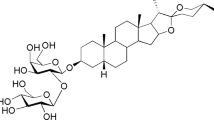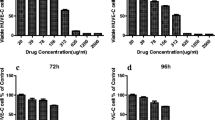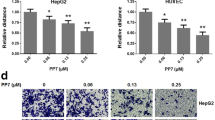Abstract
Background
Angiogenesis is the formation of new blood vessels from an existing vasculature through a series of processes such as activation, proliferation, and directed migration of endothelial cells. Angiogenesis is instrumental in the metastatic spread of tumors. Isopimpinellin, a furanocoumarin group of phytochemicals, is an anticarcinogenic agent. However, no studies have proven its antiangiogenic effects. The current study thus aimed to screen the antiangiogenic effect of isopimpinellin.
Methods and results
Human Umblical Vein Endothelial Cell (HUVEC) as an in vitro model and zebrafish embryos as an in vivo model was used in this study. The experimental results showed that isopimpinellin effectively inhibited HUVEC proliferation, invasion, migration, and tube formation, which are the key steps in angiogenesis by markedly suppressing the expression of pro-angiogenic genes VEGF, AKT, and HIF-1α. In addition, isopimpinellin exerts its anti-angiogenic effect through the regulation of miR-15b-5p and miR-542-3p. Furthermore, in zebrafish embryos, isopimpinellin inhibited the development of intersegmental vessels (ISVs) through the significant downregulation of all pro-angiogenic genes vegf, vegfr2, survivin, angpt-1, angpt-2, and tie-2.
Conclusion
Collectively, these experimental findings offer novel insights into the antiangiogenic nature of isopimpinellin and open new avenues for therapeutic approaches.






Similar content being viewed by others
Availability of data and material
The datasets analyzed during the study are available on request from the corresponding author.
References
Hanahan D, Folkman J (1996) Patterns and emerging mechanisms of the angiogenic switch during tumorigenesis. Cell 86(3):353–364
Adair TH, Jean-Pierre M (2011) Angiogenesis. Morgan & Claypool Life Sciences, San Rafael
Mashreghi M, Azarpara H, Bazaz MR, Jafari A, Masoudifar A, Mirzaei H et al (2018) Angiogenesis biomarkers and their targeting ligands as potential targets for tumor angiogenesis. J Cell Physiol 233:2949–2965
De Palma M, Biziato D, Petrova TV (2017) Microenvironmental regulation of tumour angiogenesis. Nat Rev Cancer 17:457
Folkman J (1971) Tumor angiogenesis: therapeutic implications. N Engl J Med 285:1182–1186
Kadioglu O, Seo EJ, Efferth T (2013) Targeting angiogenesis by phytochemicals. Med Aromat Plants 2:134
Ahmed S, Khan H, Aschner M, Mirzae H, Küpeli Akkol E, Capasso R (2020) Anticancer potential of furanocoumarins: mechanistic and therapeutic aspects. Int J Mol Sci 21(16):5622
Melough MM, Cho E, Chun OK (2018) Furocoumarins: a review of biochemical activities, dietary sources and intake, and potential health risks. Food Chem Toxicol 113:99–107
Kleiner HE, Reed MJ, DiGiovanni J (2003) Naturally occurring coumarins inhibit human cytochromes P450 and block benzo[a]pyrene and 7,12-dimethylbenz[a] anthracene DNA adduct formation in MCF-7 cells. Chem Res Toxicol 16:415–422
Prince M, Campbell CT, Robertson TA, Wells AJ, Kleiner HE (2006) Naturally occurring coumarins inhibit 7,12-dimethylbenz[a]anthracene DNA adduct formation in mouse mammary gland. Carcinogenesis 27:1204–1213
Wu Y et al (2014) MiR-152 reduces human umbilical vein endothelial cell proliferation and migration by targeting ADAM17. FEBS Lett 588:2063–2069
Langheinrich U (2003) Zebrafish: a new model on the pharmaceutical catwalk. BioEssays 25:904–912
Crawford AD, Esguerra CV, de Witte PAM (2008) Fishing for drugs from nature: Zebrafish as a technology platform for natural product discovery. Planta Med 74:624–632
Staton CA, Stribbling SM, Tazzyman S, Hughes R, Brown NJ, Lewis CE (2004) Current methods for assaying angiogenesis in vitro and in vivo Int. J Exp Pathol 85:233–248
Rubinstein AL (2003) Zebrafish: from disease modeling to drug discovery. Curr Opin Drug Discov Devel 6(2):218–223
Arunachalam G, Lakshmanan AP, Samuel SM, Triggle CR, Ding H (2016) Molecular Interplay between microRNA-34a and Sirtuin1 in hyperglycemia-mediated impaired angiogenesis in endothelial cells: effects of metformin. J Pharmacol Exp Ther 356:314–323
Qu K et al (2015) MicroRNAs: key regulators of endothelial progenitor cell functions. Clin Chim Acta 448:65–73
Mirossay L, Varinská L, Mojžiš J (2017) Antiangiogenic effect of flavonoids and chalcones: an update. Int J Mol Sci 19(1):27
Folkman J (1974) Proceedings: tumor angiogenesis factor. Cancer Res 34(8):2109–2113
Kubrak T, Bogucka-Kocka A, Komsta Ł, Załuski D, Bogucki J, Galkowski D, Kaczmarczyk R, Feldo M, Adamczyk-Cioch M, Kocki J (2017) Modulation of multidrug resistance gene expression by coumarin derivatives in human leukemic cells. Oxid Med Cell Longev. https://doi.org/10.1155/2017/5647281
Goodwin AM (2007) In vitro assays of angiogenesis for assessment of angiogenic and anti-angiogenic agents. Microvasc Res 74(2–3):172–183
Zhong ZF, Hoi PM, Wu GS, Xu ZT, Tan W, Chen XP et al (2012) Anti-angiogenic effect of furanodiene on HUVECs in vitro and on zebrafish in vivo. JEthnopharmacol 141:721–727
Bruce RZ (1998) Angiogenesis and tumor metastasis. Annu Rev Med 49(1):407
Eccles SA (2004) Parallels in invasion and angiogenesis provide pivotal points for therapeutic intervention. Int J Dev Biol 48:583–598
Tsai SC, Liu YC, Li CP, Huang TS, Lee Sesamin CC (2006) inhibits vascular endothelial cell growth and angiogenic activity of lung adenocarcinoma cells. J Cancer Mol 2:199–205
Robertson AL, Ogryzko NV, Henry KM et al (2016) Identification of benzopyrone as a common structural feature in compounds with anti-inflammatory activity in a zebrafish phenotypic screen. Dis Model Mech 9(6):621–632
Pore N, Jiang Z, Shu HK, Bernhard E, Kao GD, Maity A (2006) Akt1 activation can augment hypoxia-inducible factor-1alpha expression by increasing protein translation through a mammalian target of rapamycin-independent pathway. Mol Cancer Res 4(7):471–479
Ferrara N, Davis-Smyth T (1997) The biology of vascular endothelial growth factor. Endocr Rev 18:4–25
Varghese E, Liskova A, Kubatka P, Mathews Samuel S, Büsselberg D (2020) Anti-angiogenic effects of phytochemicals on miRNA regulating breast cancer progression. Biomolecules 10(2):191
Jin C, Zhao Y, Yu L, Xu S, Fu G (2013) MicroRNA-21 mediates the rapamycin-induced suppression of endothelial proliferation and migration. FEBS Lett 587:378–385
Suarez Y, Fernandez-Hernando C, Pober JS, Sessa WC (2007) Dicer dependent microRNAs regulate gene expression and functions in human endothelial cells. Circ Res 100:1164–1173
Chan LS, Yuen PY, Wong YY, Wong RN (2013) MicroRNA-15b contributes to ginsen-oside-Rg1-induced angiogenesis through increased expression of VEGFR-2. Biochem Pharmacol 86:392–400
Zheng X, Chopp M, Lu Y, Buller B, Jiang F (2013) MiR-15b and miR-152 reduce glioma cell invasion and angiogenesis via NRP-2 and MMP-3. Cancer Lett 329:146–154
He T, Qi F, Jia L, Wang S, Song N, Guo L, Fu Y, Luo Y (2014) MicroRNA-542-3p inhibits tumour angiogenesis by targeting angiopoietin-2. J Pathol 232(5):499–508
He T et al (2015) Tumor cell-secreted angiogenin induces angiogenic activity of endothelial cells by suppressing miR-542-3p. Cancer Lett 368(1):115–12538
Kaneda H, Arao T, Matsumoto K et al (2011) Activin A inhibits vascular endothelial cell growth and suppresses tumour angiogenesis in gastric cancer. Br J Cancer 105:1210–1217
Panopoulou E, Murphy C, Rasmussen H et al (2005) Activin A suppresses neuroblastoma xenograft tumor growth via antimitotic and anti-angiogenic mechanisms. Cancer Res 65:1877–1886
Breit S, Ashman K, Wilting J et al (2000) The N-myc oncogene in human neuroblastoma cells: down-regulation of an angiogenesis inhibitor identified as activin A. Cancer Res 60:4596–4601
Wang B, Chen S, Zhao J, Xiang B, Gu X, Zou F, Zhang Z (2019) ADAMTS-1 inhibits angiogenesis via the PI3K/Akt-eNOS-VEGF pathway in lung cancer cells. Transl Cancer Res 8(8):2725–3273
Stack MS, Gately S, Bafeti LM, Enghild JJ, Soff GA (1999) Angiostatin inhibits endothelial and melanoma cellular invasion by blocking matrix-enhanced plasminogen activation. Biochem J 340:77–84
Kim I, Kim JH, Moon SO, Kwak HJ, Kim NG, Koh GY (2000) Angiopoietin-2 at high concentration can enhance endothelial cell survival through the phosphatidylinositol 3’-kinase/Akt signal transduction pathway. Oncogene 19(39):4549–4552
Sheng J, Xu Z (2016) Three decades of research on angiogenin: a review and perspective. Acta Biochim Biophys Sin 48(5):399–410
Bottazzi B, Garlanda C, Salvatori G, Jeannin P, Manfredi A, Mantovani A (2006) Pentraxins as a key component of innate immunity. Curr Opin Immunol 18:10–15
Grant K, Loizidou M, Taylor I (2006) Endothelin. In: Handbook of biologically active peptides. Academic Press, New York, pp 447–452
Oxmann D, Held-Feindt J, Stark A et al (2008) Endoglin expression in metastatic breast cancer cells enhances their invasive phenotype. Oncogene 27:3567–3575
Paramasivam A, Kalaimangai M, Sambantham S, Anandan B, Jayaraman G (2012) Anti-angiogenic activity of thymoquinone by the down-regulation of VEGF using zebrafish (Danio rerio) model. Biomed Prev Nutr 2(3):169–173
Chen K, Wang C, Fan Y et al (2018) Identification of mundoserone by zebrafish in vivo screening as a natural product with anti-angiogenic activity. Exp Ther Med 16(6):4562–4568
Brown JL, Cao ZA, Pinzon-Ortiz M, Kendrew J, Reimer C, Wen S, Zhou JQ, Tabrizi M, Emery S, McDermott B et al (2010) A human monoclonal anti-ANG2 antibody leads to broad antitumor activity in combination with VEGF inhibitors and chemotherapy agents in preclinical models. Mol Cancer Ther 9:145–156
Hashizume H, Falcon BL, Kuroda T, Baluk P, Coxon A, Yu D, Bready JV, Oliner JD, McDonald DM (2010) Complementary actions of inhibitors of angiopoietin-2 and VEGF on tumor angiogenesis and growth. Cancer Res 70:2213–2223
Huang H, Lai JY, Do J, Liu D, Li L, Del Rosario J, Doppalapudi VR, Pirie-Shepherd S, Levin N, Bradshaw C et al (2010) Specifically targeting angiopoietin-2 inhibits angiogenesis, Tie2-expressing monocyte infiltration, and tumor growth. Clin Cancer Res 17:1001–1011
Thurston G, Daly C (2012) The complex role of angiopoietin-2 in the angiopoietin-tie signaling pathway. Cold Spring Harb Perspect Med 2(9):a006550
Ma A, Lin R, Chan PK, Leung JC, Chan LY, Meng A et al (2007) The role of survivin in angiogenesis during zebrafish embryonic development. BMC Dev Biol 7:50
Acknowledgements
This study was funded and supported by the Department of Science and Technology (DST), Science and Engineering Research Board (SERB), Early Career Research (ECR) Grant (DST No.: ECR/2015/000265). The authors also thank DST-FIST, UGC-SAP and DHR-MRU for the infrastructural facility.
Funding
This work was supported by Science and Engineering Research Board (SERB), Early Career Research (ECR) Grant (DST No.: ECR/2015/000265).
Author information
Authors and Affiliations
Contributions
SB: conceptualization, methodology, investigation, writing—original draft. VR: conceptualization, methodology. SS: conceptualization, writing—review and editing. AB: conceptualization, supervision, writing—review and editing.
Corresponding author
Ethics declarations
Conflict of interest
The authors declare no conflicts of interest in this work.
Ethical approval
The ethical clearance was granted by institutional animal ethical committee with the approval number [Approval No.: 01/36/2015].
Consent to participate
Not applicable.
Consent for publication
Not applicable.
Additional information
Publisher's Note
Springer Nature remains neutral with regard to jurisdictional claims in published maps and institutional affiliations.
Supplementary Information
Below is the link to the electronic supplementary material.
Rights and permissions
About this article
Cite this article
Bhagavatheeswaran, S., Ramachandran, V., Shanmugam, S. et al. Isopimpinellin extends antiangiogenic effect through overexpression of miR-15b-5p and downregulating angiogenic stimulators. Mol Biol Rep 49, 279–291 (2022). https://doi.org/10.1007/s11033-021-06870-4
Received:
Accepted:
Published:
Issue Date:
DOI: https://doi.org/10.1007/s11033-021-06870-4




